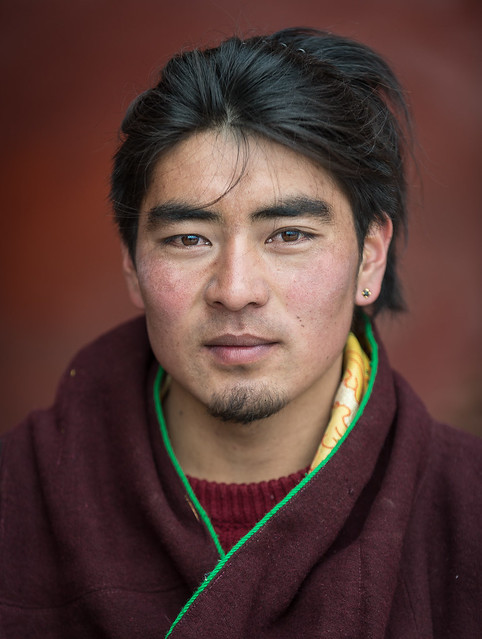FEATURES|COLUMNS|Ancient Dances
Candid Amdo
Photographer Joe Tymczyszyn is a retired aeronautical engineer and pilot, who acquired his first camera—a Kodak Brownie—in 1950. He has been devoted to photography ever since. Once he retired from work, he dedicated himself to capturing human beauty in unlikely places: female bodybuilding contests, cosplay conferences throughout Asia (ComiCons), tribal fusion belly dance performances, gay pride parades, and, remarkably, eight trips to photograph the beauty and beautiful people at ethnically Tibetan Buddhist New Year ceremonies.
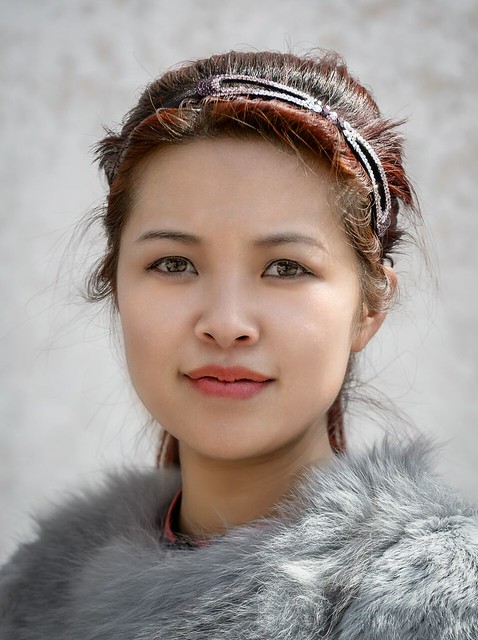
2015. This photo was taken at a Tu Zu minority Buddhist monastery named
Gonlong in a Tu Zu Autonomous County, which is just north of Xining, the
capital of Qinghai Province. Most of the Buddhists who attended the Cham
that day were of the Tu Zu minority, however, I can’t say if the girl herself
was Tu Zu.
I was taking photos of some other people at the monastery during the
Cham in this location, when a family walked in: father, mother, daughter,
and I recall a grandmother. The daughter was stunningly beautiful. First I
photographed the whole family together then just the daughter. I sent
them the photos afterwards.
There was snow on the ground in the area, so she could be called a
Snow Princess, but that’s a Western term.
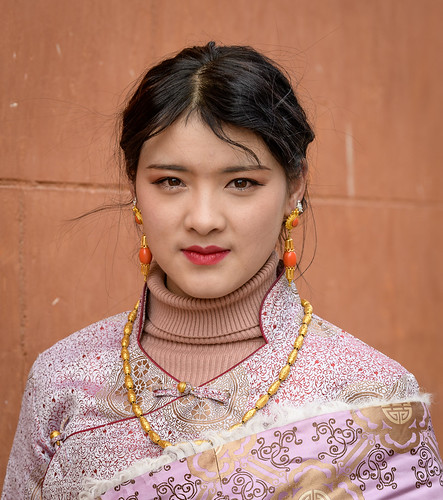
2018. Wu Village Lower Monastery, outside Tong Ren. This woman
was not only beautiful, she has an interesting expression that, to me,
expressed strength of character.
What was once the Tibetan province of Amdo, an historically significant region for the development of Vajrayana Buddhism, now forms part of the three Chinese provinces of Gansu, Qinghai, and Sichuan. Traveling with Canadian tour operators and Cham enthusiast Susan and William Trimble, Joe has visited Amdo eight times during the traditional Monlam, or New Year, festivities. These are great annual events, as much social as ritual.

2014. In a small village in Qinghai, rather remote, but near a
monastery. This Muslim woman was in a Muslim food market
selling meat and vegetables.
She was happy to talk with a foreigner who could speak
Mandarin because there are so few foreigners that find their
way to that village, and fewer yet speak Mandarin or go into a
meat market. At first this girl was too shy to pose, but in the
end she let me shoot. Beautiful eyes.
Since I was such a novelty, and there were few customers at
that time of day, most of the shopkeepers had little to do but
watch me, all in the friendliest way.
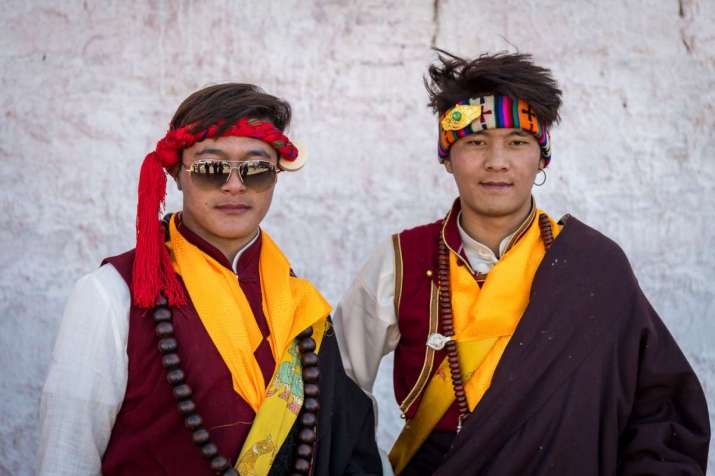 2018. Gormang Monastery in Aba Tibetan Autonomous County, Sichuan Province. Two adult ceremonial horsemen.
2018. Gormang Monastery in Aba Tibetan Autonomous County, Sichuan Province. Two adult ceremonial horsemen.There are the Cham dances—which will be featured in this column next month—and there are the Buddhist faithful, for whom the Monlam festivals still continue, despite the very small number of foreign tourists and an increasing number of Han Chinese tourists. Seeing a Cham dance ceremony attended by mostly local people is becoming difficult to do in India and Bhutan. These opportunities, made possible by Susan and William Trimble, and artistically seized upon by Joe, are rare to find, and as such, these photos are quite special.
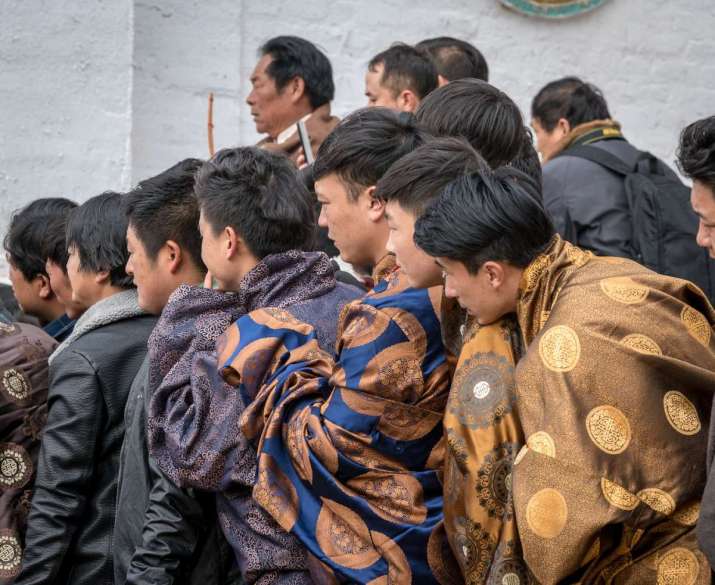 2018. Wu Village Lower Monastery. Young men stand very close together at a good viewing spot for the Cham. It was one of the more exciting times during the Cham when the deity was getting close to defeating the evil spirits, so everyone wanted to see the action.
2018. Wu Village Lower Monastery. Young men stand very close together at a good viewing spot for the Cham. It was one of the more exciting times during the Cham when the deity was getting close to defeating the evil spirits, so everyone wanted to see the action.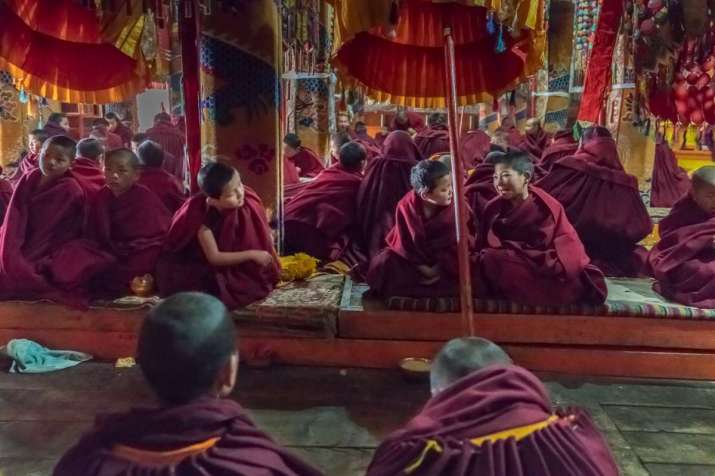 2018. Wu Village Lower Monastery. Young monks chat during a long ceremony. I had stood in the same place long enough for them to forget about me and start chatting among themselves. I took the shot from my waist instead of raising the camera to my eye. Near the center of the photo is the pole that supports a circular banner used by the monks for parades in ceremonies—annoying from a photographer’s point of view, but these photos are supposed to be real, not photoshopped, so I didn’t remove it.
2018. Wu Village Lower Monastery. Young monks chat during a long ceremony. I had stood in the same place long enough for them to forget about me and start chatting among themselves. I took the shot from my waist instead of raising the camera to my eye. Near the center of the photo is the pole that supports a circular banner used by the monks for parades in ceremonies—annoying from a photographer’s point of view, but these photos are supposed to be real, not photoshopped, so I didn’t remove it.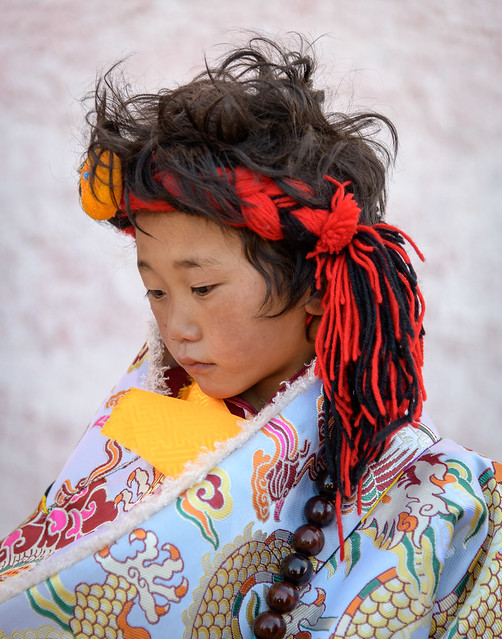
2018. Gormang Monastery. This is in Aba Tibetan Autonomous County,
Sichuan Province. Gormang Monastery was where we saw ceremonial horses
and the horsemen. This is a young horseman. His father was very proud that
I took his picture. The father asked that I send him the photo and I did.
“I speak native English, plus Chinese and French, and enjoy traveling to places where I can talk with the people I photograph,” Joe explained. “I like to shoot photos of people. I talk with them before I shoot. I almost never take a shot of a person who I haven’t talked with and gained their agreement to let me shoot. They often ask me to send them a digital copy of the photo, and I do that.
“In the past I have mainly shot at events where everyone wants their picture to be taken, such as cosplay shows, bodybuilding contests, and parades. The Tibetan minority Buddhists at the monastery ceremonies normally agree to let me photograph them in their beautiful costumes. They are open and friendly people and happy to meet foreigners who can speak Mandarin. The costumes are beautiful. The women are beautiful. I’ve gone to Qinghai, Gansu, Sichuan, and the Tibet Autonomous Region eight times to do this.”
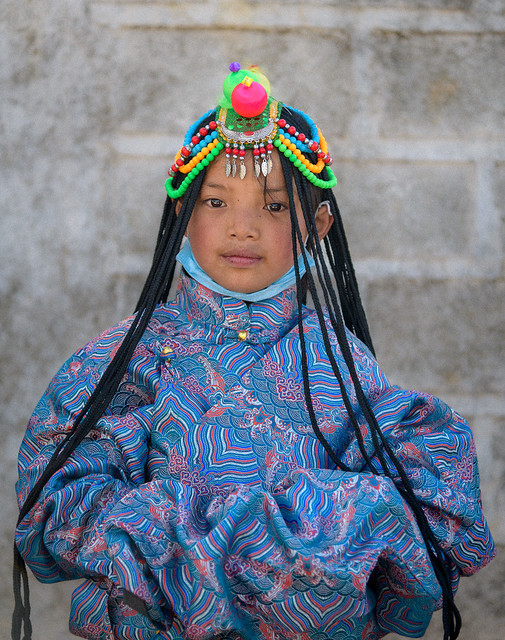
2018. Na Xi Monastery in Aba Tibetan Autonomous County, Sichuan Province.
The Cham was performed that day. This little girl was only seven years old and
very beautiful. I asked her parents if she could pose and they happily agreed.
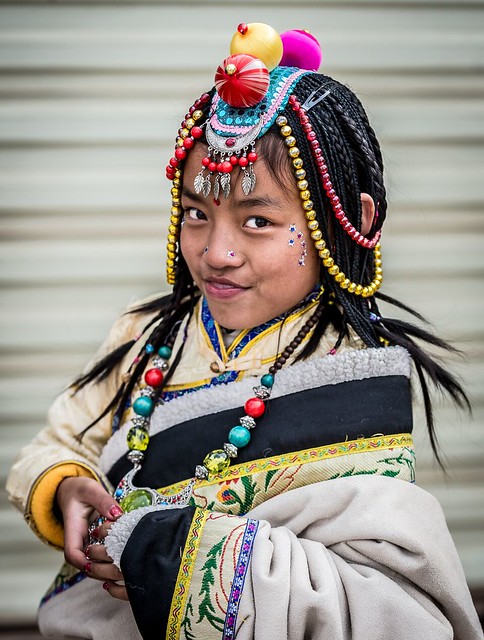
2014. Wu Village Upper Monastery outside Tong Ren. This little girl was a
scamp. She had such a cute, mischievous look when she posed. I think she
thought it was really funny to be photographed by a foreigner. There aren’t
a lot of foreigners in Tong Ren.
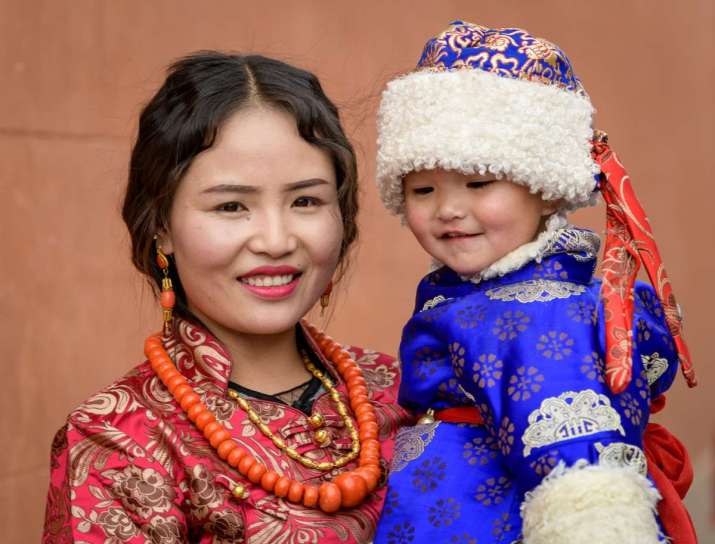 2018. Wu Village Lower Monastery. Not too hard to figure out why I asked this young mother to pose with her child!
2018. Wu Village Lower Monastery. Not too hard to figure out why I asked this young mother to pose with her child!Of course, Amdo no longer exists as a political reality or a coherent culture. Calling it Tibet is like calling Pakistan “India” because you wish it was. Amdo now exists only in the memory and imagination. But the Tibetan faithful still exist, now often as a minority population among the millions of Han Chinese and many Hui Muslims who have migrated into these areas. This faith, the enduring family culture, remains for now, bereft of the feudal economy, religion, and politics that once gave it life. It is not common that a photographer of Joe’s skill focuses on the people of Chinese Tibet, and it is a pleasure to introduce his work to you here. Because these faces reflect the Buddhist faithful of all times, we have titled this portfolio of images, Candid Amdo. It includes captions by the photographer.
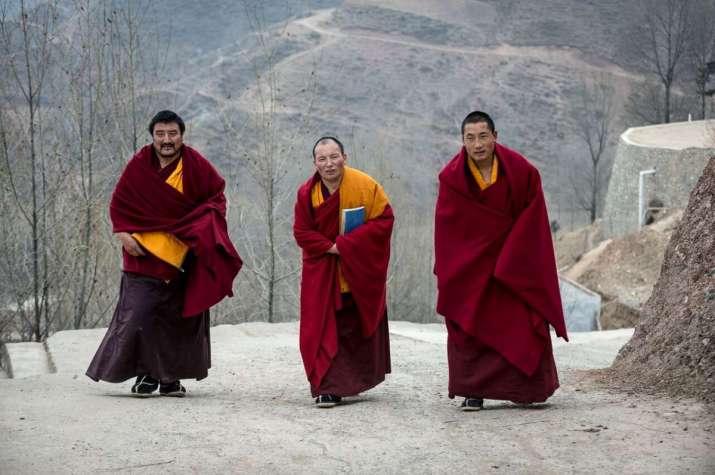 Small Bon monastery south of Tong Ren. As we neared the parking lot to get in our car and leave, I looked back and saw these three Lamas climbing the hill toward me. So I took a long shot with my telephoto. The background shows that this was deep in the hills far from any city. It was a Bon Buddhist Monastery high in a small hillside village.
Small Bon monastery south of Tong Ren. As we neared the parking lot to get in our car and leave, I looked back and saw these three Lamas climbing the hill toward me. So I took a long shot with my telephoto. The background shows that this was deep in the hills far from any city. It was a Bon Buddhist Monastery high in a small hillside village.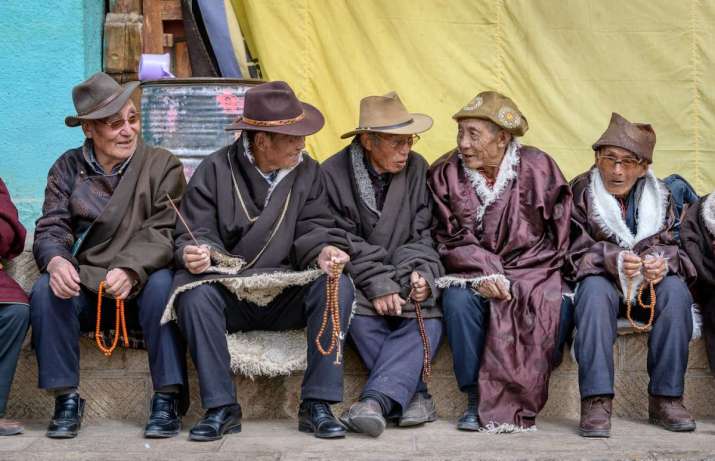 2018. Wu Village Lower Monastery outside Tong Ren. Older men watching the cham. The old men seem to sit in the same prime location every year. The Tibet Buddhist way seems to be: the old men sit with the old men, the old ladies sit with the old ladies, the single women sit with the single women, etc. I say “sit” but there are not enough seats so “stand” is often the way, especially for the younger people. This is not a hard and fast rule, sometimes the whole family or all the women and children in the family sit together.
2018. Wu Village Lower Monastery outside Tong Ren. Older men watching the cham. The old men seem to sit in the same prime location every year. The Tibet Buddhist way seems to be: the old men sit with the old men, the old ladies sit with the old ladies, the single women sit with the single women, etc. I say “sit” but there are not enough seats so “stand” is often the way, especially for the younger people. This is not a hard and fast rule, sometimes the whole family or all the women and children in the family sit together.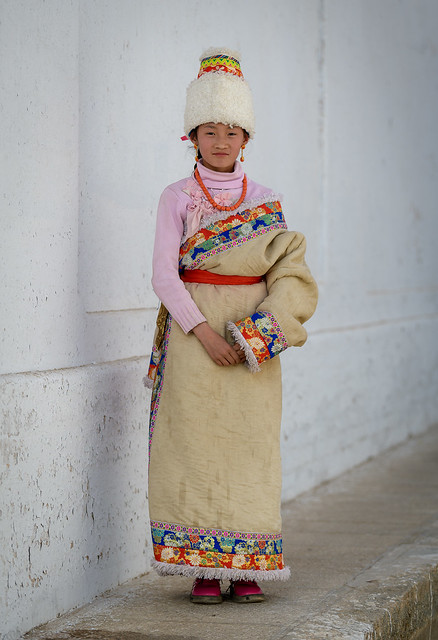
2018. Gormang monastery. This was very near the Cham, less than
100 yards away, at one of the special monastery buildings that housed
a giant statue of Buddha. After going in the to see the Buddha, the
Buddhists tend to walk around the outside of the building in clockwise
direction. I saw this young woman as she started around on the left side,
so I went to the right side to be ready to ask her to pose for me when
she got there. The right side was in the shade in the afternoon, good
for shooting portraits. She shows her beautiful costume.
See more
Related features from Buddhistdoor Global
An Eye, a Lens, a Dance
Contemplating the Headless Buddha: The Photographic Work of Dinh Q. Lê
Self, Other, and the Spaces Between: Behind the Lens with Niçoise Photographer Fiorenza Menini
Buddhism in Contemporary China Through a Photographer’s Eye


